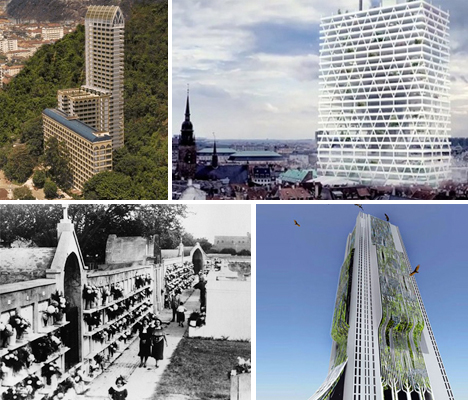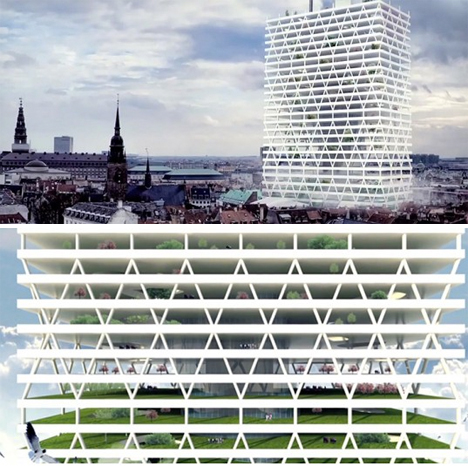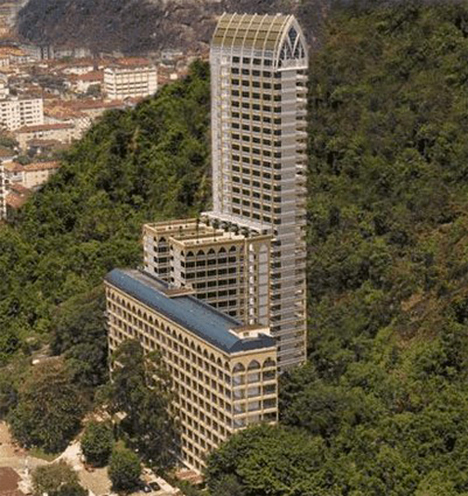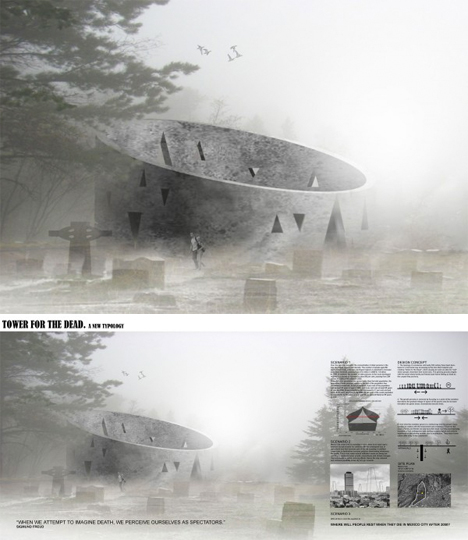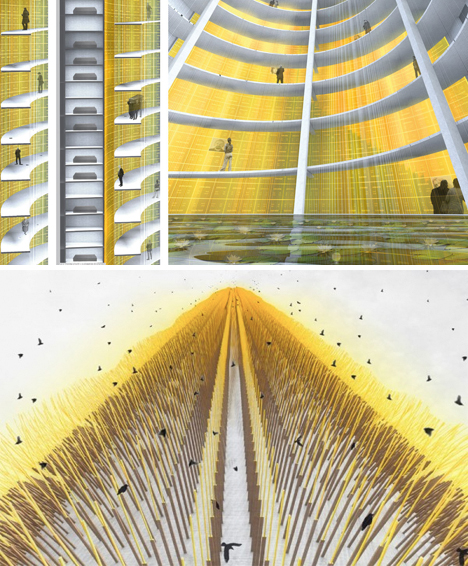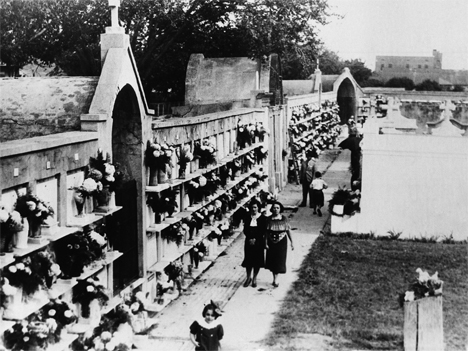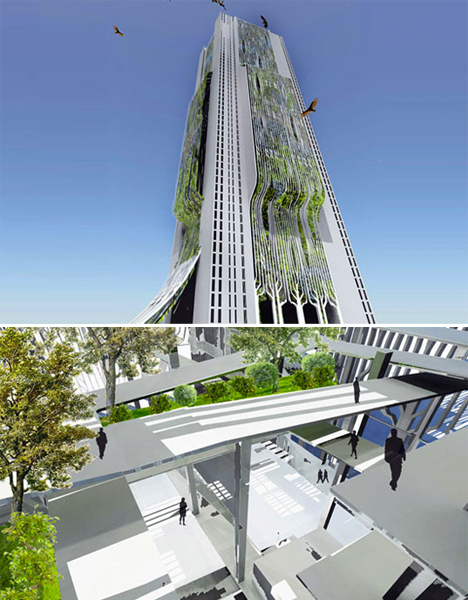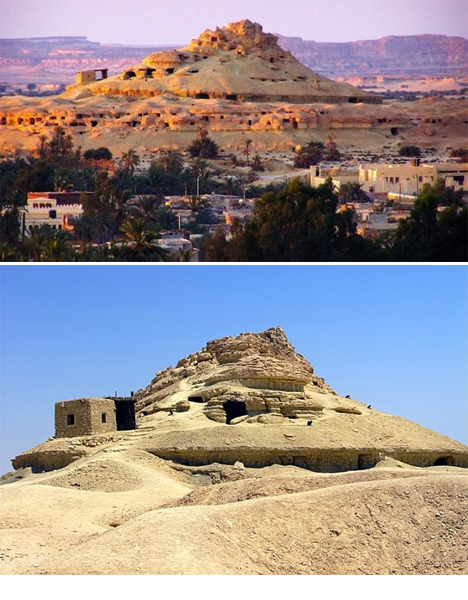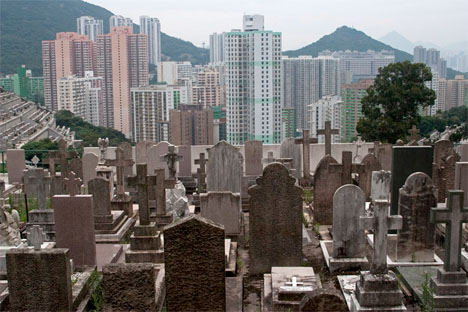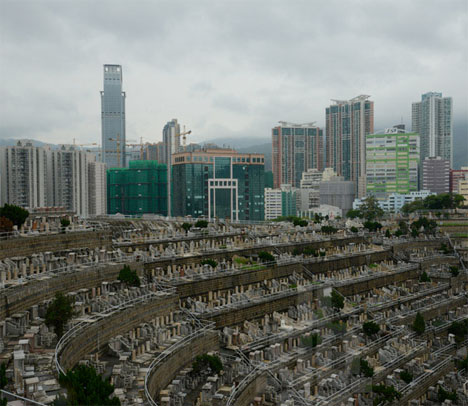A skyscraper filled with corpses may sound morbid, but soon, such things may become a necessity. The earth is already packed with dead housed in oversized caskets that have been designed to outlive us all – so what are we going to do with the never-ending stream of human bodies as we face life’s greatest inevitability?
Skyscraper Cemetery for Norway
A metal exoskeleton around a central core serves as the framework for a multi-story graveyard that looks, on each individual floor, the way any ordinary graveyard would. It’s got trees, benches and memorials. The only difference is, it’s high above ground level, and roofed by the next level of graves. Norweigian designer Martin McSherry envisions the Skyscraper Cemetery that can help solve the problem of lack of burial space in the country, with a crane permanently situated beside the structure to constantly add new floors as needed.
Memorial Necropole Ecumenica, Brazil
The world’s tallest existing cemetery is Brazil’s Memorial Necropole Ecumenica, a 32-story high rise where tombs are rented by the year and private memorial rooms go for about $105,000. Because of the hot Brazilian climate, bodies must be interred within 24 hours, so the MCE, as it’s known, is open 24 hours a day, 365 days a year. The building also contains a chapel, lagoon, peacock garden, waterfalls, an aviary full of parrots and toucans and even a small restaurant.
Tower for the Dead, Mexico City
The population of residents aged 65 and older is expected to triple in developing countries over the next four decades. That’s a big problem when it comes to burying the dead, especially in places like Mexico City where buildable area is very scarce. Creating more conventional cemeteries would mean losing valuable agricultural land and what few unspoiled green spaces are left. This proposal, Tower for the Dead, actually combines vertical necropoles with inverted skyscrapers for an 820-foot-deep subterranean complex conceived as a massive screw driving into the earth. The experience might be a little intense, as each floor has a theme based on a stage of grief.
“This project proposes an underground vertical cemetery for Mexico City – a vision that takes into consideration the overpopulation, the scarcity of land, and the psychological and sensory experience of grieving. The ‘Tower of the Dead’ allows the family members of the deceased to be reborn, after a trip to the underworld, where they just buried their loved one.”
Vertical Cemetery for Paris
This vertical cemetery concept for land-challenged Paris would create “a symbolic tower with a rightful place within the city that the deceased so much loved,” a city that currently has so little space for graves that many remains have still not been properly buried. A skylight pours natural light into the center of the tower, down into a water pond at the base, with a spiral ramp offering a walkway to the top floor. Flexible filaments on the outside of the tower each stand for a deceased person, aiming to embody their essence as they move in the wind.
Stacked Cemeteries of New Orleans
New Orleans is one city that already stacks its dead vertically, up to four tombs high. The reason for this is simple: the city is set well below sea level, so the water table is far too high for underground burial. Dig just a few feet down, and you’ll hit soggy sand. For a while, residents attempted it anyway, stacking heavy stones on top of the caskets to hold them down, but storms would bring them floating up to the surface. Families are typically stacked together within individual vaults. At the city’s infamous Lafayette Cemetery, human remains are even interred right in the walls that surround it.
Moshka Tower Cemetery, Mumbai
The Moshka Tower was designed for Mumbai to free up a significant amount of ground space for the living, accommodating all four of the major cultures and religions found within the city (Hindu, Muslim, Christian and Parsi.) Facilities are available for both garden burial and cremation. A tower of silence is located on the roof for Parsis, and additional space is available for worship, prayer and meditation. The multi-layered facade is filled with vegetation to absorb heat and CO2, and new technology enables more sustainable cremation that doesn’t fill the air with pollution.
Mountain of the Dead, Egypt
Egypt’s Mountain of the Dead, also known as Gebel al Mawta, is a Roman-era burial site that towers above the landscape of the Siwa Oasis, looking a bit like an ant hill. Made of limestone, it was developed during the 26th Dynasty of Egypt, and served as a hiding place for soldiers during World War II. Tombs cover virtually every square inch of its base as well as its terraces and all sides of the conical portion. Many of the tombs have been raided over the centuries, and robbery continues to be a problem.
Amphitheater for the Dead: Hong Kong Hillside Cemeteries
Look out onto the hillsides from a high-rise in Hong Kong and you’ll see something that’s highly uncommon in the west: tier after tier of graves built onto hillsides resembling ancient amphitheaters. Each grave within these cemeteries is shoehorned beside the other. It didn’t take long for this trend to die down in the city – the practice began in the ’60s, and by the ’80s, space ran out, so officials had resorted to interring bodies in nearby high-rise buildings. Hong Kong is twice as dense as New YOrk and four times as crowded as London, so it’ll be interesting to see what they come up with next.
